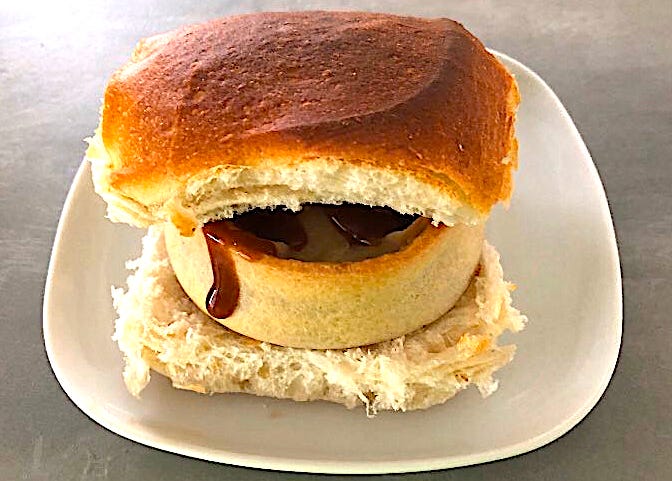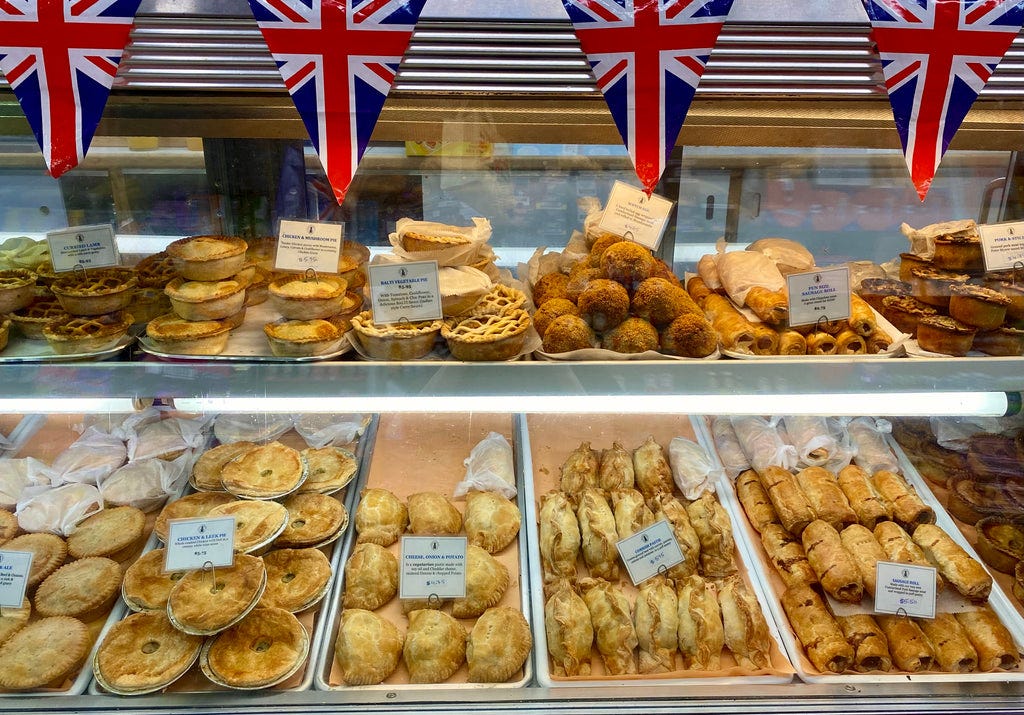Notable Sandwiches #74: The Glasgow Oyster
AKA: pie barm, peh 'n piece, Ballingry Big Mac, and Wigan Kebab
Welcome back to Notable Sandwiches, the feature where we trip merrily through the bizarre and mutable document that is Wikipedia’s List of Notable Sandwiches, in alphabetical order. This week, a Scottish specialty: the Glasgow Oyster, written by our beloved Scotsman David Swanson. — Talia
Last year, when British YouTube sensation Amelia Dimoldenberg asked her twitter followers about a seemingly simple sandwich, she could hardly have anticipated the response. To her first question, there was universal agreement: Oh, yes, there most certainly is (although to call it “a Scottish cuisine” might be stretching things.) To the third question, regarding the taste, there was further agreement (“aye they taste fucking class ameel.” That’s a rave in Scots.) But as to the middle question—“What is it?”—there was little consensus beyond the constituent ingredients involved:
“Its called a ‘roll and pie’ or ‘pie and roll’ depending where in scotland, and its a scotch pie in a (normally buttered) roll...worth a try”
“I live in Lancashire and heard someone call it a growler”
“It’s called a piece and pie!”
“Roll 'n peh, its an aye from me”
“Also known as a Ballingry Big Mac. Heaven”
“The Highlanders are trying to steal the fine Lancashire dish of the Wigan kebab.”
“A Glasgow Oyster and it's magical.”
This final appellation—in which the roll is an oyster shell, and the pie a pearl—has the honor of representing the “pie roll” genus in Wikipedia’s sandwich taxonomy.
In Scotland and Northern England the meat pie is something between a staple and a delicacy: a seemingly humble comestible that’s treated with reverence. And it would seem that in separate communities across this swath of Britain, the notion arose that enveloping this staple/delicacy in a well-buttered roll might yield something greater than the sum of its parts. Multiple discovery is a concept this newsletter has explored before. “Whether we’re talking about science or sandwiches,” I wrote last year, “this tendency of inventions to arise—in parallel at the right time, among disparate minds—does not exclude their provenance from fierce contention.”
Generally the debate centers around claims of creation: was the French Dip invented at Philippe or Cole's? Where did the first Cuban sandwich appear, Tampa or Miami? In the case of today’s sandwich, the question isn’t so much who came up with the idea. (It was probably some hungry Glaswegian—or Wiganite, or Dundonian—who was served a meat pie so scalding hot that the only way to protect his or her fingers was to place it in a roll.) I’m more interested in who can claim its naming rights. In the Greater Manchester/Merseyside corridor they call it a “Wigan Kebab,” as evinced in the viral video below, in which a hapless vlogger consumes one, alongside local delicacies “smack barm pey wet” and “babby’s yed,” in a communion of carbohydrates.
The Glasgow Oyster is what Talia has dubbed an “orphan sandwich”—one that’s included on Wikipedia’s list but doesn’t have a page of its own. I have to admit, despite years living in Scotland, I never encountered a Glasgow Oyster, whether called that or some other alias. The given definition—“a scotch pie on a morning roll”—is slightly more specific than just a “pie on a roll,” but try telling that to a Wigan native.
In some form or another, the meat pie exists in cuisines across the globe, and it’s history goes back millennia. But no 21st century Glaswegian would mistake an Ancient Greek version for a Scotch Pie, which traditionally consisted of minced mutton, heavily spiced and baked in a hot-water pastry shell. There are, of course, countless other types of British meat pie—steak-and-ale, pork, rabbit, steak-and-kidney—to say nothing of pasties or bridies. The Glasgow Oyster, however, specifies that the pie be Scotch.
Other regional variations are less strict. Wigan, a former industrial hub roughly equidistant from Manchester and Liverpool, is famous for its love of pies. Fittingly, when Amelia Dimoldenberg sent out her twitter query, the most common response was the Wigan Kebab, also known locally as a “slappy”, “jakey”, or “pie barm.” But from what I can gather, this particular version can accommodate any type of meat pie. In other words, a Glasgow Oyster could be considered a Wigan Kebab, but a Wigan Kebab can only be called a Glasgow Oyster if it’s using a Scotch Pie.
The Sword and the Sandwich is a newsletter about serious extremism and equally serious sandwiches. Please consider supporting this work with a paid subscription:
If I had encountered this sandwich during my time in Scotland, it would have likely been called something different again. In Fife, where I spent my college years, a pie on a roll is variously known as a “Ballingry Big Mac” or “Cowden Big Mac”, depending on the town. If you’re looking for a Glasgow Oyster in Dundee, you’ll want to ask for a “peh 'n a piece.” Elsewhere in Scotland it goes by Tartan Kebab, Govan Oyster, Scottish Kebab, Kirkie Oyster, roll and bridie, pie piece, pie butty, and Kirkaldy Salad. In Australia they call it a “piewich.”
Given my background and my ostensible authority in the sandwich arts (by dint of this newsletter, anyway) I felt mildly ashamed at my ignorance, and was determined to remedy it. As it turns out, in New York—a city of 20 million people, home to every cuisine you can imagine—I was unable to source a Scotch Pie, let alone a Glasgow Oyster. But I was determined to make do. If I couldn’t locate a proper Glasgow Oyster, surely I could approximate a Wigan Kebab, with its more permissive strictures.
So, earlier this week, I stopped at Myers of Keswick in Greenwich Village, my go-to shop for British specialties. While they didn’t have Scotch Pies, there were other offerings that seemed close enough, and I bought a selection: steak and ale, pork, and mutton curry. None of these was quite right—the pork pie had close to the right consistency, but the wrong protein; beef is often used in a modern Scotch Pie, but it should be minced, not cubed; and while mutton is the traditional meat, curry is a more recent addition.
To the uninitiated, this sandwich might seem like a carb-on-carb cholesterol bomb. But, while far from healthy, it’s surely no more carb-laden than a chip butty, or worse for your heart than a doughnut sandwich. But while I can’t really vouch for the authenticity, I was happy with the result: all three of my home-made whatever-you-call-ems hit the spot. As for the surfeit of carbs—the hat-on-a-hat nature of the thing—I wasn’t bothered. After all, a club sandwich and a Big Mac both come with extra bread, and no one seems to worry about the consequences. And next month I’ll be piling stuffing onto my post-Thanksgiving pilgrim sandwich, and this isn’t really all that different.
Far from being redundant, the fresh-baked rolls slathered in butter helped insulate both hand and pie, while sopping up any stray grease or juices. The steak-and-ale version evokes a stew sandwich, not a bad thing on an October day. The curried mutton was delicious, something like a samosa sandwich. And the pork pie was certainly tasty, but to be honest, the roll didn’t serve much purpose given the pie’s temperature (warm) and consistency (solid).
So while I can’t truly enthuse about a proper Glasgow Oyster, I also can’t imagine a better treat to to eat during a chilly “Old Firm” match, or an early morning walk home from the pub. Whether you want to call it a Wigan Kebab or a pie barm or a roll ‘n peh or a Ballingry Big Mac, it earns its spot in the Wikipedia canon. It may not be “Scottish cuisine,” but would a sandwich by any other name taste as great? Or to quote Robert Burns, that great bard of Scottish literature:
What though on hamely fare we dine,
Wear hoddin grey, an’ a that;
Gie fools their silks, and knaves their wine;
A Man’s a Man for a’ that:
For a’ that, and a’ that,
Their tinsel show, an’ a’ that;
The honest man, tho’ e’er sae poor,
Is king o’ men for a’ that.










I do like a scotch pie, but the equivalent for me in the 80s would be a meat and potato pie from Oddies bakery, between two slices of buttered white bread, bit of HP sauce for tang. Between potato, pastry, bread - enough carbs.
Memories of Scotch pies, fresh out the backdoor of the all-night bakery in St Patrick Square back in my wasted Scottish youth. If only I'd thought of wrapping one in an equally fresh morning roll!